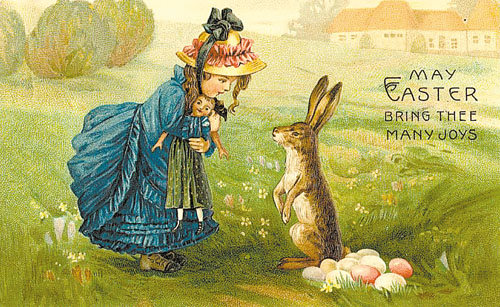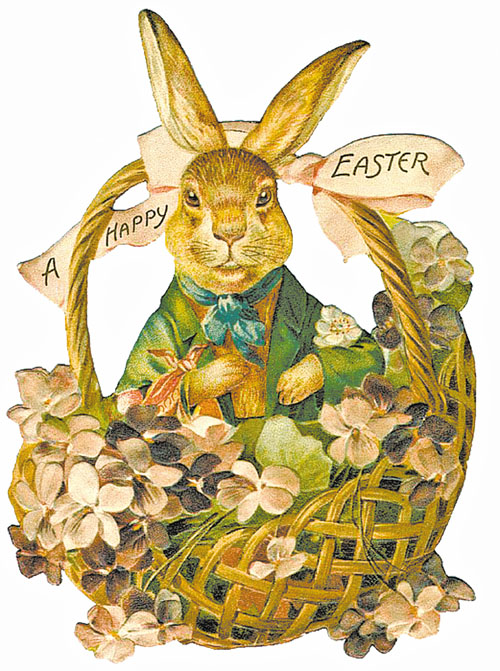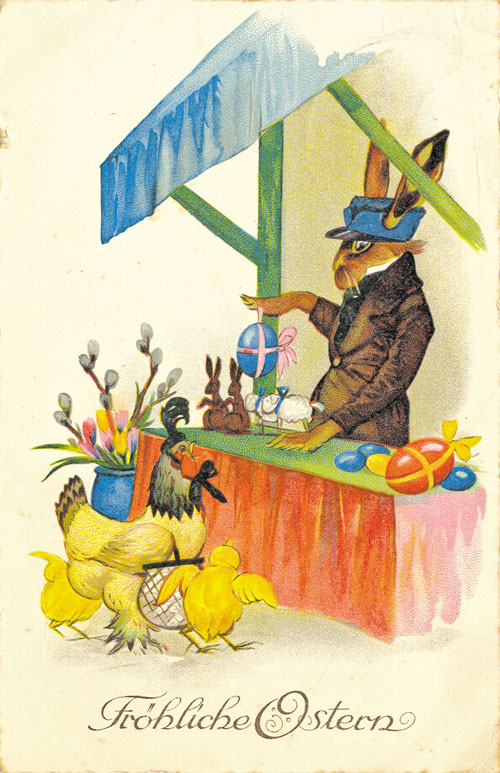European traditions, or How the rabbit began to lay Easter eggs
By Olena SHAPIRO. Illustrations courtesy of the author
During Eastertide celebrations, all of us, especially children, enthusiastically go on a traditional spree: we buy a paschal cheesecake and get it blessed, dye Easter eggs, and choose a customary souvenir – the chocolate bunny. It is all too clear about cheesecake and dyed eggs… But where did the bunny lope from and how did this animal become part of a traditional Bright Easter celebration?
This character, which an old legend says presents obedient children with chocolate eggs for good behavior in the past year, is alike to Santa Claus (Saint Nicholas) who brings gifts to obedient children on Christmastide. The only difference is that the rabbit must show resourcefulness to put eggs at night into the hats that children have placed under the garden shrubs or in some other secret place, while Santa Claus brings gifts in a big red bag and puts them in children’s woolen socks. The didactic motif is clear and unambiguous: Christmas and Easter gifts should reinforce our belief in that positive behavior will be fairly rewarded, albeit in a secret way.
However, the figure of a rabbit that has a fantastic (for rodents) ability to lay eggs does not at all fit in with any fairytale traditions, but we are so much accustomed to this that we never think about why the bunny was assigned such a strange duty. And, finally, if the gift is an egg, why is it a rabbit, not a hen?

Folkloristic and mythological sources say that the figure of a rabbit emerged well before Christianity, in the ancient pagan times. One of the many and widely popular legends about the bunny has it that the Ark came across a mountain top as it sailed during the Deluge, its bottom suddenly cracked and made a gap. Water could have filled the whole Ark, and it would have sunk, dashing Noah’s hopes, but a little rabbit, unfairly called a coward, saved the situation at a crucial moment. It sat down and closed the gap with its tail. The legend says that this exploit did not remain unnoticed, and the good fame of a brave hero is still alive and may have contributed to the birth of the image of a paschal bunny. Later, in 1680, the first literary story was published about a rabbit that is a prototype of the paschal one, for it would lay and hide eggs in the garden.
This character gradually won popularity throughout Europe, and the feast of Osterhase (in German) became children’s most coveted and joyous one. An immigration wave brought the image of a funny and kind rabbit to the US. The immigrants settled in Dutch Country, south-eastern Pennsylvania. At the time, “Dutch” was applied to all the first German-speaking European settlers who had immigrated in the late 17th – early 18th centuries. It is they who brought in this legend and the remarkable tradition of presenting kids with sweet bunny-shaped marzipans on this springtime holiday.
Today, it still pleases children not only to get and eat this gift, but also to sink into the atmosphere of a feast and play in it. In olden times, children, not yet spoilt with TV game devices and mechanically controlled toys, entertained themselves differently on Easter Day: they would make an egg nest from an old hat, hide it in secret place on the sly, and look forward to a gift in the morning.

Curiously, there were local characters in various parts of Europe, which were associated with paschal gifts and seriously rivaled the bunny: eggs were laid by the fox in Hesse, the rooster in Saxony, the stork in Alsace, the cuckoo in Bavaria. But it still considered that the rabbit laid the “right” egg and became the winner.
Easter bunnies are divided into two categories: token statuettes (as a symbol of Eastertide) and sweet rabbits intended to be eaten by kids.
And, to conclude with, it is worthwhile to say how far the love of this sweet and kind character has gone. The Easter bunny’s aficionados have set up a museum of their pet. In 1991 a collector, Manfred Klauda, opened the Easter Bunny Museum in Munich, which has been entered into the Guinness Book of Records. The museum has more than a thousand objects, including porcelain, wooden, rag, clay, papier mache, sugar, and wax rabbits; molds to make Easter bunnies from marzipans and chocolate; postcards; figures of rabbits with watches and clockwork rabbits.
Audiences can see 19th-century toy bunnies. The ceremoniously dressed couples of dandy rabbits and their fashion-conscious female companions with coquettish hats on promenade “paw-in-paw.” Strictly sticking to historical chronology, the museum also displays World War One-time bunnies that wear a military uniform and stand by the cannon. To reenact various scenes of fairytale bunnies’ everyday life, the museum exhibits special living rooms and wooden boxes with a theater-like set and animal figures.
Olena Shapiro is an art historian
Newspaper output №:
№28, (2014)Section
Time Out





